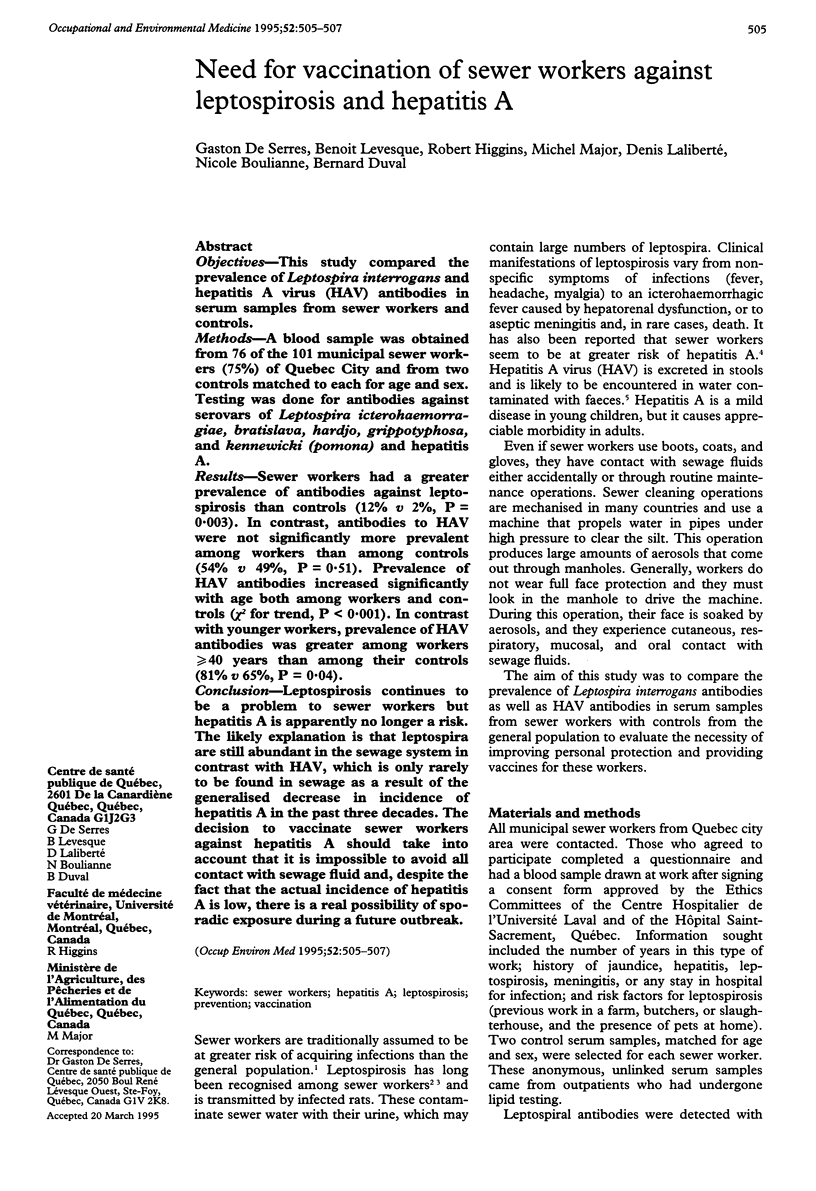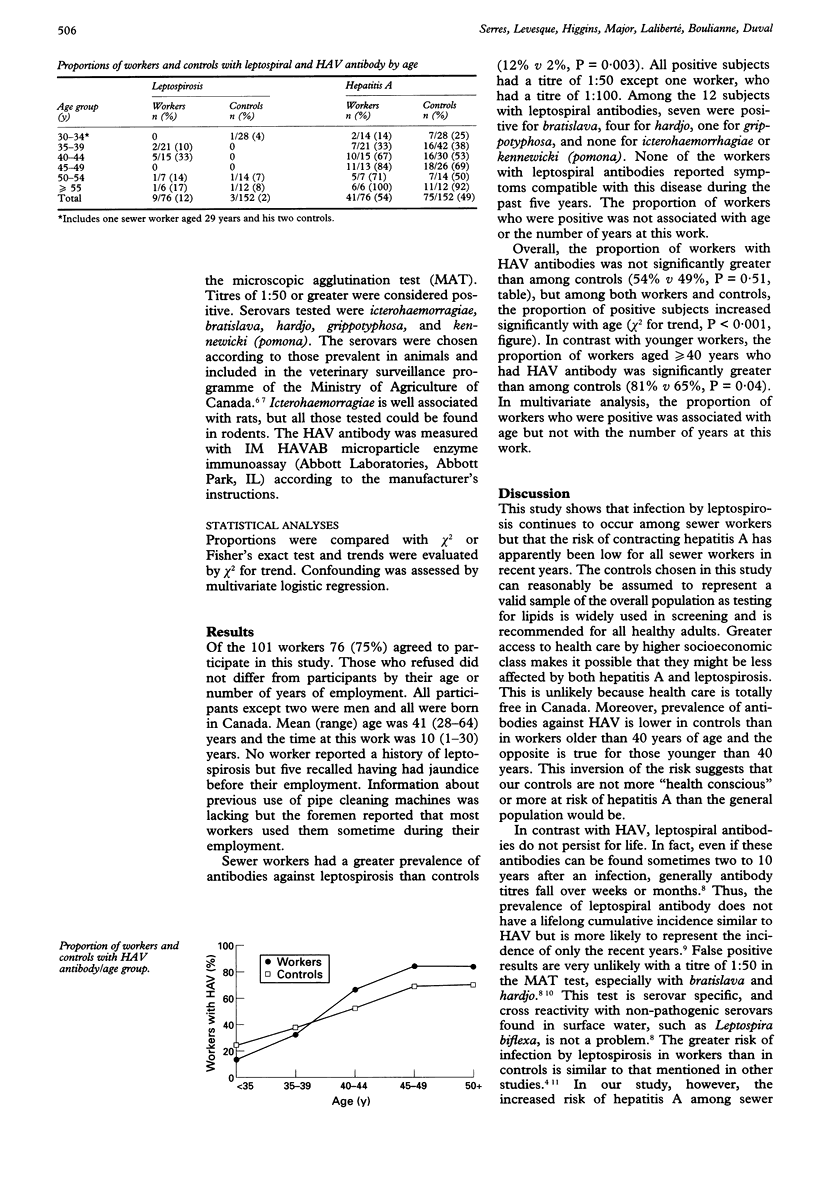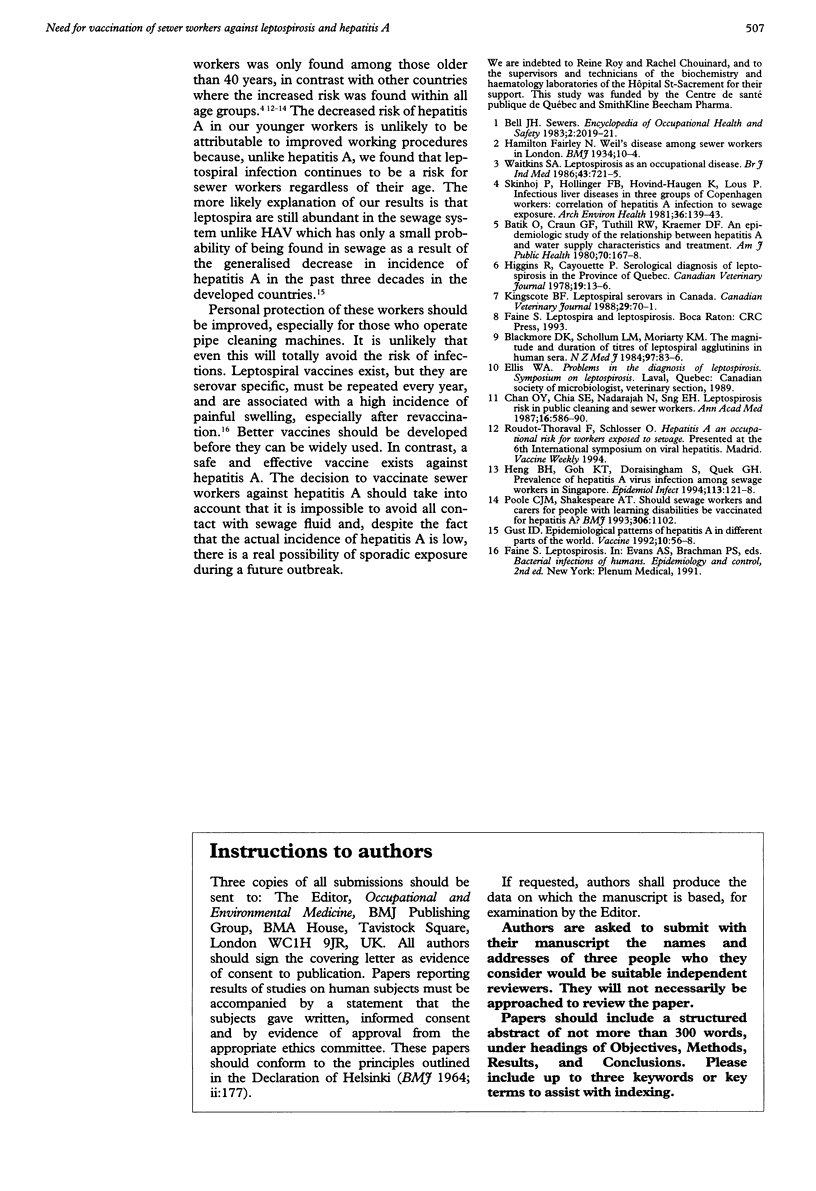Abstract
OBJECTIVES--This study compared the prevalence of Leptospira interrogans and hepatitis A virus (HAV) antibodies in serum samples from sewer workers and controls. METHODS--A blood sample was obtained from 76 of the 101 municipal sewer workers (75%) of Quebec City and from two controls matched to each for age and sex. Testing was done for antibodies against serovars of Leptospira icterohaemorragiae, bratislava, hardjo, grippotyphosa, and kennewicki (pomona) and hepatitis A. RESULTS--Sewer workers had a greater prevalence of antibodies against leptospirosis than controls (12% v 2%, P = 0.003). In contrast, antibodies to HAV were not significantly more prevalent among workers than among controls (54% v 49%, P = 0.51). Prevalence of HAV antibodies increased significantly with age both among workers and controls (chi 2 for trend, P < 0.001). In contrast with younger workers, prevalence of HAV antibodies was greater among workers > or = 40 years than among their controls (81% v 65%, P = 0.04). CONCLUSION--Leptospirosis continues to be a problem to sewer workers but hepatitis A is apparently no longer a risk. The likely explanation is that leptospira are still abundant in the sewage system in contrast with HAV, which is only rarely to be found in sewage as a result of the generalised decrease in incidence of hepatitis A in the past three decades. The decision to vaccinate sewer workers against hepatitis A should take into account that it is impossible to avoid all contact with sewage fluid and, despite the fact that the actual incidence of hepatitis A is low, there is a real possibility of sporadic exposure during a future outbreak.
Full text
PDF


Selected References
These references are in PubMed. This may not be the complete list of references from this article.
- Batik O., Craun G. F., Tuthill R. W., Kraemer D. F. An epidemiologic study of the relationship between hepatitis A and water supply characteristics and treatment. Am J Public Health. 1980 Feb;70(2):167–168. doi: 10.2105/ajph.70.2.167. [DOI] [PMC free article] [PubMed] [Google Scholar]
- Blackmore D. K., Schollum L. M., Moriarty K. M. The magnitude and duration of titres of leptospiral agglutinins in human sera. N Z Med J. 1984 Feb 8;97(749):83–86. [PubMed] [Google Scholar]
- Chan O. Y., Chia S. E., Nadarajah N., Sng E. H. Leptospirosis risk in public cleansing and sewer workers. Ann Acad Med Singapore. 1987 Oct;16(4):586–590. [PubMed] [Google Scholar]
- Heng B. H., Goh K. T., Doraisingham S., Quek G. H. Prevalence of hepatitis A virus infection among sewage workers in Singapore. Epidemiol Infect. 1994 Aug;113(1):121–128. doi: 10.1017/s0950268800051530. [DOI] [PMC free article] [PubMed] [Google Scholar]
- Higgins R., Cayouette P. Serological diagnosis of leptospirosis in the Province of Quebec. Can Vet J. 1978 Jan;19(1):13–16. [PMC free article] [PubMed] [Google Scholar]
- Poole C. J., Shakespeare A. T. Should sewage workers and carers for people with learning disabilities be vaccinated for hepatitis A? BMJ. 1993 Apr 24;306(6885):1102–1102. doi: 10.1136/bmj.306.6885.1102. [DOI] [PMC free article] [PubMed] [Google Scholar]
- Skinhøj P., Hollinger F. B., Hovind-Hougen K., Lous P. Infectious liver diseases in three groups of Copenhagen workers: correlation of hepatitis A infection to sewage exposure. Arch Environ Health. 1981 May-Jun;36(3):139–143. doi: 10.1080/00039896.1981.10667618. [DOI] [PubMed] [Google Scholar]
- Waitkins S. A. Leptospirosis as an occupational disease. Br J Ind Med. 1986 Nov;43(11):721–725. doi: 10.1136/oem.43.11.721. [DOI] [PMC free article] [PubMed] [Google Scholar]


